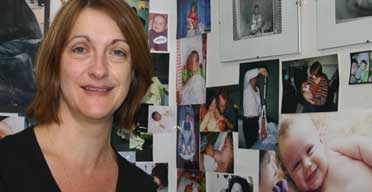
A GP surgery in London is providing treatment that could provide a model for the type of care the government has promised to provide for all pregnant women.
The National Institute for Health and Clinical Excellence (Nice) is preparing guidelines to be issued in late summer on care for women in labour, and last month Patricia Hewitt, the health secretary, promised that every pregnant women would be able to opt for a home birth if wanted by 2009.
But questions have already been raised about whether the Nice guidelines will fundamentally change provision, and whether Ms Hewitt's target is achievable.
The Oakwood midwives' clinic in south London shows how model care could operate. All pregnant women who attend the GP surgery at Forest Hill Road have access to a group of midwives whose goal is to give them the best experience they could hope for. The midwifery practice aims to increase home births, but supports all women referred to it, even if they would prefer a hospital birth or if complications dictate it.
"We believe in home births because we believe they are safe, but our main aim is to offer choice and continuity of care to all expectant women, something we feel is missing," said Linda Pullinger, one of the original members of the group.
Many women see different health professionals throughout their pregnancy, labour and birth, and postnatally, but Oakwood's women are given a named midwife who carries out nearly all of their antenatal and postnatal appointments and in many cases delivers their baby at home or in hospital.
The clinic's women can leave their final decision on where they give birth as late as labour itself. "They page us when they go into labour, we go out and assess them when it is necessary and take it from there," said Jacqueline Binnie, Oakwood's new leader.
Oakwood also takes outside referrals for women who have had a difficult birth in the past. But with each midwife seeing between 35 and 40 women a year, they have a waiting list and many are turned away.
Most routine antenatal appointments take place in the home. "Because there is less pressure on time, the woman knows you are there as long as you can be," said Jacqueline. "So it's easier to explore birth choices and discuss private matters than in a GP surgery or a busy antenatal clinic," where she said the "focus tends to be on the more medical aspects of birth".
Oakwood also invites women who have recently delivered to talk to those whose due dates are imminent, and birth partners are encouraged to attend an appointment at 36 weeks to talk about labour. "It's an opportunity to allay any fears or anxieties they have and give them advice on what they [the partner] can bring to it as well," said Jacqueline.
Because they cannot guarantee that the named midwife will be on duty when labour begins, the women are given the opportunity to meet all six midwives at the practice, so that they will be supervised by someone with whom they are familiar. About two-thirds of the women on their books have their named midwife at the birth, and almost all will have one of the team.
Serena O'Brien, who had a planned caesarean section last year because of placenta praevia (when the placenta lies in the lower part of the womb which can lead to the placenta being torn away during labour), is being supervised again by Oakwood for her second pregnancy.
She said: "One of the team was with me during the operation and I received a lot of support from them afterwards, especially with breastfeeding. It was Julie [another Oakwood midwife] who came to see me in hospital the next day and got my baby latched on. The hospital midwives tried to help but she had the magic touch. I was so pleased to see her."
About 65% of Oakwood's women gave birth in hospital last year, and the midwives' advocacy role becomes key if complications arise during labour, said Jacqueline.
"When you're in pain and you're tired and you feel really emotional and vulnerable, it's difficult to actually hear your own voice. It's our job to make sure she [the woman in labour] understands what is being said to her and she is given time to make her own decision."
Oakwood is one of eight midwifery practices run from King's College hospital NHS foundation trust (KCH), five of which are attached to GP surgeries and which all work in slightly different ways.
Katie Yiannouzis, head of midwifery at KCH, said Oakwood was a model of very good practice. "They [Oakwood and their women] build up this strong trusting relationship, so almost when the woman goes into labour, the midwife knows what she wants, she doesn't really have to ask. The midwife can pre-empt what she's going to need, and she can advocate for her in a big way if things don't turn out how she initially thought.
"It requires a huge amount of commitment and not every midwife would be able to work in that way because of personal circumstances or their level of motivation," she said.
Mary Newburn, head of policy research at the National Childbirth Trust, said it strongly supported the work of practices like Oakwood. But while there was growing evidence that this type of care meant women with straightforward pregnancies were more likely to have a straightforward birth, there was not yet enough thoroughly researched evidence to back up the benefits, to influence the new Nice guidelines.
"This type of service offered by Oakwood is considered too expensive and too demanding for midwives by many in the NHS," said Ms Newburn, "but if you look at the overall ratios of midwives to women it looks like it could be possible for far, far more women to have this kind of care."

